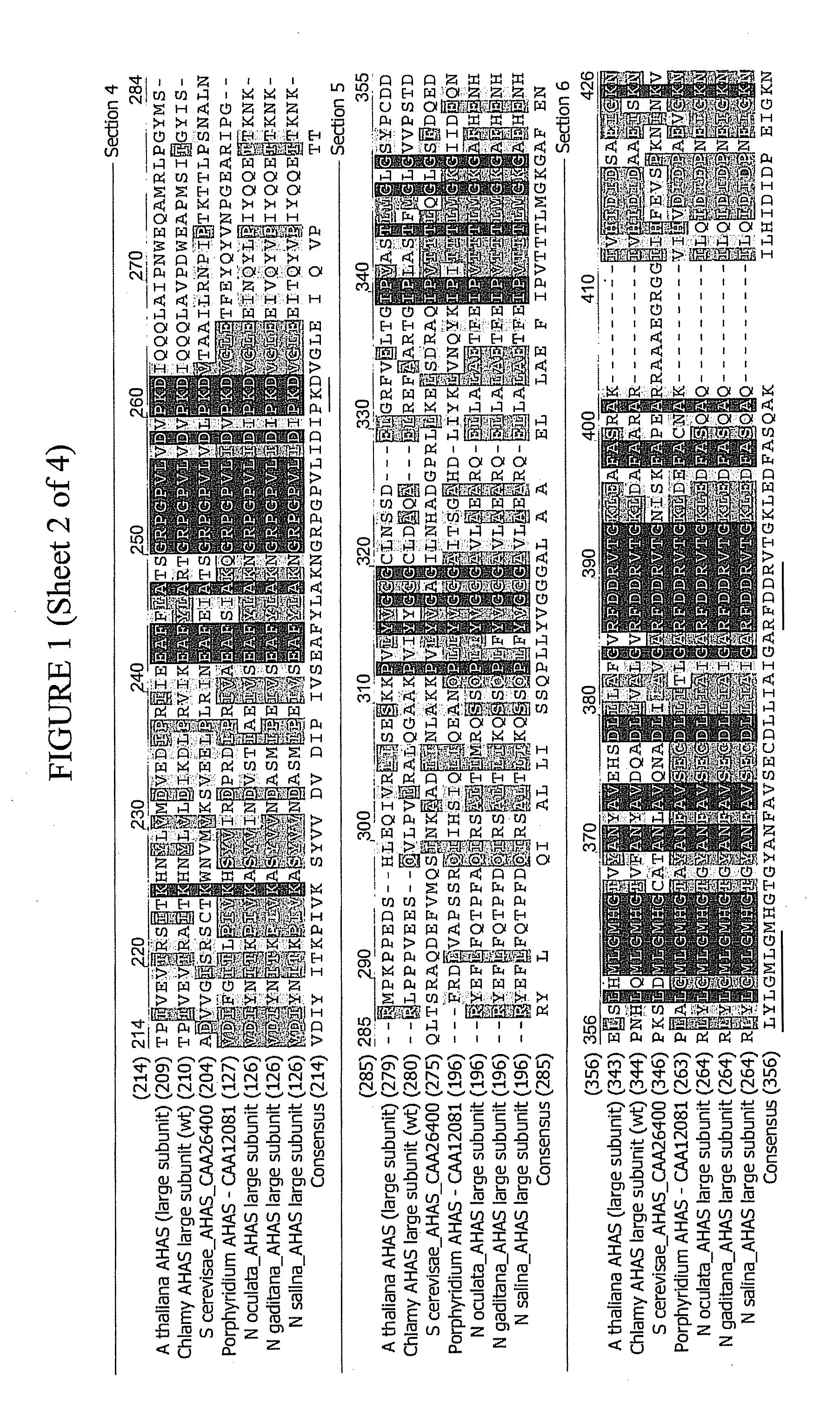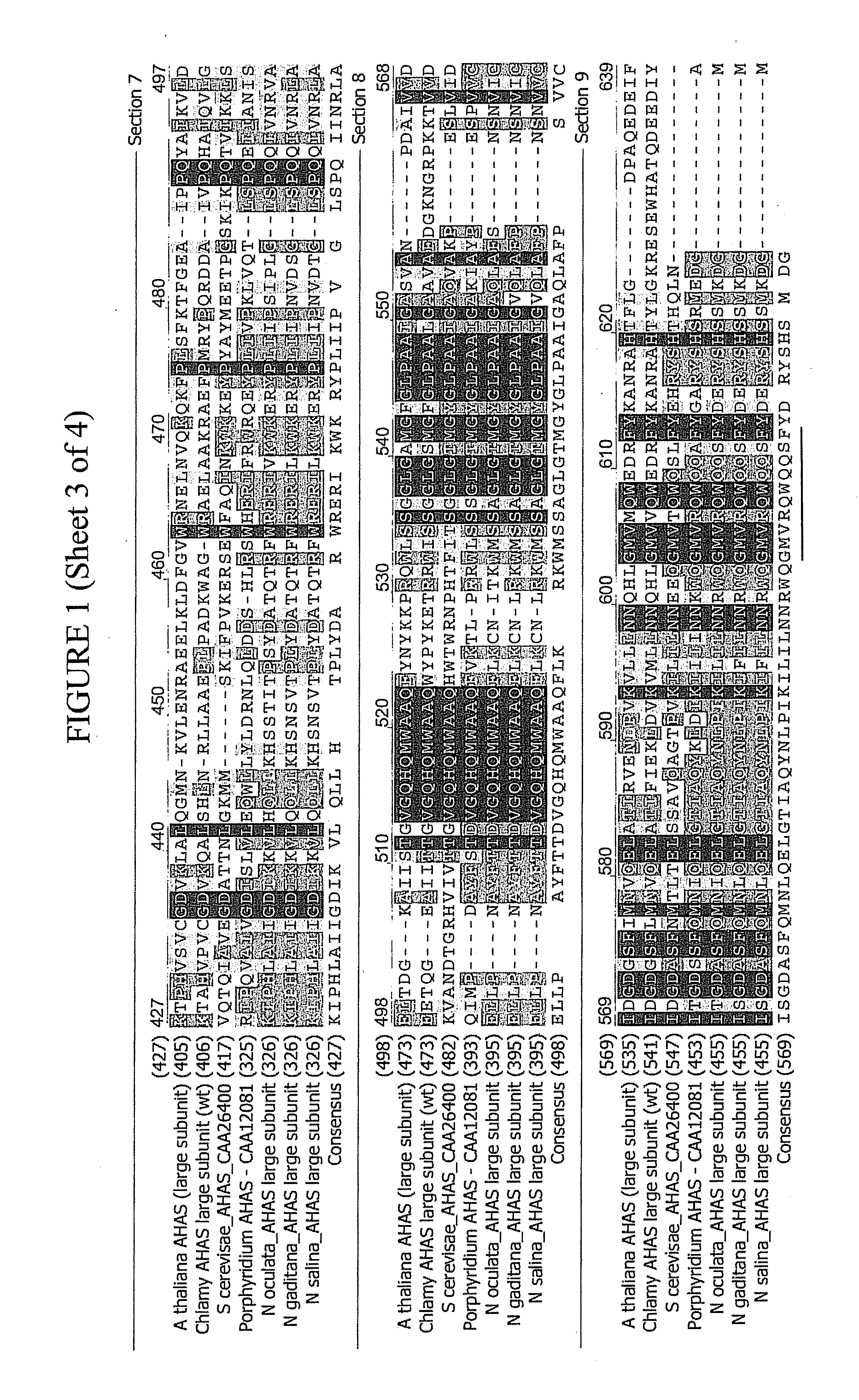Compositions and methods for modulating the sensitivity of cell to AHAS inhibitors
a technology of ahas inhibitors and modulators, applied in the field of molecular biology and genetics, can solve problems such as potential challenges in the optimization of culture conditions for selected i>nannochloropsis /i>species, and achieve the effect of modulating the sensitivity of cells and conferring modulated sensitivity to ahas inhibitors
- Summary
- Abstract
- Description
- Claims
- Application Information
AI Technical Summary
Benefits of technology
Problems solved by technology
Method used
Image
Examples
example 1
Identification and Isolation of an Acetohydroxyacid Synthase from Nannochloropsis gaditana
[0179]The applicants of the present application identified and isolated a nucleic acid molecule encoding a novel acetohydroxyacid synthase from chloroplast DNA content of the microalga Nannochloropsis gaditana CCMP1894 strain. The algal strain was obtained from the Provasoli-Guillard National Center for Marine Algae and Microbiota (NCMA, Maine, U.S.A.), which is formerly the National Center for Culture of Marine Phytoplankton (CCMP). The coding sequence of this novel gene, named SGI-Ng110602, together with its 503-bp upstream regulatory sequence, is provided in the Sequence Listing as SEQ ID NO: 2.
[0180]A homology search for the nucleotide sequence of the SGI-Ng110602 gene was conducted using the DDBJ / GenBank / EMBL database. Sequence identity and similarity were also determined using GenomeQuest™ software (Gene-IT, Worcester Mass. USA). In a BLASTX homology analysis, the nucleotide sequence of ...
example 2
Construction of Modified N. gaditana AHAS Genes
[0183]In order to create novel mutant alleles of the N. gaditana AHAS gene with reduced sensitivity to AHAS inhibitors that can be used as selectable markers for subsequent transformation experiments, the applicants of the present application introduced several point mutations in the coding sequence of the N. gaditana AHAS gene.
[0184]Nannochloropsis gaditana AHAS K173T Mutant.
[0185]Applicants engineered a K173T mutation in the N. gaditana AHAS polypeptide by altering its coding sequence using the technique of “splicing by overlap extension by the polymerase chain reaction” (SOE-PCR) as described in Ho et al. (Gene 77, 1:51-9, 1989), with minor modifications. The first set of PCRs generated two fragments—a 5′ half product and a 3′ half product—using total N. gaditana genomic DNA as template. The 5′ fragment was generated using primers oSGI-JU-78 (5′-CGGTACCCGGGGATCCagagtggctcccaacatatc-3′; SEQ ID NO:17) and oSGI-JU-75 (5′-cttctaaccctacat...
example 3
Isolation of AHAS Genes from Herbicide-Resistant Nannochloropsis Cells
[0193]The present applicants observed that the growth of Nannochloropsis sp. is strongly inhibited by the herbicidal compound metsulfuron methyl (MSM, Sigma-Aldrich, CAS #74223-64-6). This compound has been previously reported to be a potent inhibitor of AHAS activity in several organisms. The applicants performed additional testing to determine that 30 μM of MSM could be used to effectively suppress wild-type growth.
[0194]Applicants subsequently identified eighteen (18) mutant isolates of the Nannochloropsis gaditana CCMP1894 strain that showed high levels of resistance to the herbicidal compound MSM. In fact, cells of each of the 18 isolates grew efficiently in growth media containing the herbicide MSM at concentrations where wild-type growth was found to be significantly impaired. The sequences of the endogenous AHAS gene from each of these MSM-resistant isolates were PCR-amplified and sequenced to determine th...
PUM
| Property | Measurement | Unit |
|---|---|---|
| Fraction | aaaaa | aaaaa |
| Fraction | aaaaa | aaaaa |
| Composition | aaaaa | aaaaa |
Abstract
Description
Claims
Application Information
 Login to View More
Login to View More - R&D
- Intellectual Property
- Life Sciences
- Materials
- Tech Scout
- Unparalleled Data Quality
- Higher Quality Content
- 60% Fewer Hallucinations
Browse by: Latest US Patents, China's latest patents, Technical Efficacy Thesaurus, Application Domain, Technology Topic, Popular Technical Reports.
© 2025 PatSnap. All rights reserved.Legal|Privacy policy|Modern Slavery Act Transparency Statement|Sitemap|About US| Contact US: help@patsnap.com



